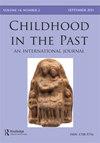Children’s Literature, Food, and Identity in Times of Crisis and Change: A Literary-Historical Approach
IF 0.5
Q3 ANTHROPOLOGY
引用次数: 0
Abstract
The last three decades have witnessed the development of studies of food in children’s literature. The expansion of this particular area within children’s literature studies stems from a combination of factors. From a scientific viewpoint, over this period of time children’s literature studies and food studies underwent significant development and consolidation as research areas in their own right. In all likelihood, this happy coincidence contributed to a surge of interest among children’s literature scholars in the significance of eatables in children’s stories: indeed, from a narrative standpoint, food has a crucial role in stories aimed at a primary child audience. And last, but definitely not least and certainly related to the factors listed above, interest in food and eating in children’s literature also depends on the simple fact that, for a wide range of reasons, all human cultures share an interest in food. It is indeed a widely accepted notion among researchers involved in food studies to any degree that, in Massimo Montanari’s words, ‘food is culture’ (2006). Given that food is such a powerful component of an individual’s cultural identity, what happens when it is no longer possible to access food, in general, and food constituting ‘my’ culture, in particular? And what role does food have in building new cultural, national, and individual identities? Over the last few years, the COVID pandemic impacted on underprivileged constituencies’ access to food and on how cultures all over the world related to food and nutrition; war events, of which the war in Ukraine is the most recent example, provoke the uprooting of whole communities, with consequent lack of access to food, especially to food that is part of these communities’ cultural identity. In the wake of events such as these, it becomes important to consider the questions above, especially when children are involved, because of their limited physical power and political and bodily autonomy. Childhood and Food: Literary-Historical Perspectives (c. 19-20th centuries) tackles these questions, looking at how literature for and about children represented the connection between food, children, and cultural identity at moments of dramatic social, cultural, and economic change over the last two centuries. In her seminal article ‘Some uses of food in children’s literature’, Katz (1980) wrote: ‘understand the relations between the child and food,... and you understand the workings of the world of the young’. ‘An examination of what’s eaten, by whom, when, and where’, she continues, ‘gives one a portrait of children’s manners, problems, and危机与变革时期的儿童文学、食物与身份认同:文学史观
过去三十年见证了儿童文学中食物研究的发展。这一特定领域在儿童文学研究中的扩展源于多种因素的结合。从科学的角度来看,在这段时间里,儿童文学研究和食品研究作为其自身的研究领域经历了重大的发展和巩固。很可能,这种愉快的巧合促使儿童文学学者对儿童故事中食物的重要性产生了浓厚的兴趣:事实上,从叙事的角度来看,食物在针对主要儿童观众的故事中发挥着至关重要的作用。最后,但绝对不是最不重要的,肯定与上述因素有关,儿童文学中对食物和饮食的兴趣也取决于一个简单的事实,即由于各种原因,所有人类文化都对食物感兴趣。用马西莫·蒙塔纳里的话来说,“食物就是文化”(2006),这确实是参与食品研究的研究人员广泛接受的概念。鉴于食物是个人文化身份的一个强大组成部分,当人们无法再获得食物,尤其是构成“我的”文化的食物时,会发生什么?食物在建立新的文化、国家和个人身份方面发挥着什么作用?在过去几年里,新冠肺炎疫情影响了弱势群体获得食物的机会,以及世界各地的文化如何与食物和营养相关;乌克兰战争就是最近的一个例子,战争事件导致整个社区背井离乡,从而无法获得食物,尤其是作为这些社区文化特征一部分的食物。在发生此类事件后,考虑上述问题变得很重要,尤其是当涉及儿童时,因为他们的体力以及政治和身体自主性有限。《童年与食物:文学历史视角》(约19-20世纪)探讨了这些问题,探讨了在过去两个世纪社会、文化和经济发生剧烈变化的时刻,儿童文学和关于儿童的文学如何代表食物、儿童和文化认同之间的联系。Katz(1980)在她的开创性文章《儿童文学中食物的一些用途》中写道:“理解孩子和食物之间的关系,。。。你了解年轻人世界的运作方式她继续说道,“对吃什么、由谁吃、何时吃、在哪里吃的检查,可以描绘出孩子们的举止、问题和
本文章由计算机程序翻译,如有差异,请以英文原文为准。
求助全文
约1分钟内获得全文
求助全文
来源期刊

Childhood in the Past
Social Sciences-Anthropology
CiteScore
0.90
自引率
0.00%
发文量
16
期刊介绍:
Childhood in the Past provides a peer-reviewed, interdisciplinary, international forum for the publication of research into all aspects of children and childhood in the past, which transcends conventional intellectual, disciplinary, geographical and chronological boundaries. The editor welcomes offers of papers from any field of study which can further knowledge and understanding of the nature and experience of childhood in the past.
 求助内容:
求助内容: 应助结果提醒方式:
应助结果提醒方式:


